Restaurant CRM Essentials: Elevate Your Customer Experience
Discover top restaurant CRM solutions to enhance guest relations and drive repeat business with this expert guide.
Part 1. Restaurant CRM Essentials: Elevate Your Customer Experience
Part 2. CRM for Restaurants: Top Solutions for Superior Service
Part 3. Restaurant CRM Software: Streamline Your Service
Maximizing Guest Satisfaction with Advanced CRM Solutions
In the bustling world of hospitality, a robust restaurant CRM system is not just a luxury—it’s a necessity for any establishment that aims to thrive. The right CRM tools can transform the way you interact with your customers, creating a seamless and personalized experience that encourages loyalty and boosts your reputation.
Understanding Your Customer’s Journey
It all starts with understanding the customer journey. From the moment a diner contemplates visiting your restaurant to the instant they share their experience online, every touchpoint is an opportunity to impress. Here’s how a CRM can make a difference at each stage:
- Discovery: Your CRM can enhance visibility through targeted marketing campaigns.
- Booking: Simplify reservations with an integrated booking system.
- Dining: Personalize the dining experience by tracking customer preferences.
- Feedback: Collect and manage reviews to improve service quality.
- Retention: Implement loyalty programs to keep diners coming back.
CRM Features that Drive Satisfaction
When selecting a CRM, focus on features that directly contribute to customer happiness:
- Reservation Management: Ensures a smooth booking experience.
- Order History Analysis: Tailor recommendations based on past orders.
- Marketing Automation: Send personalized deals and event invites.
- Feedback Collection: Promptly address concerns to show you care.
To illustrate the before and after effects of implementing a CRM, consider the following table:
| Metric | Before Implementation | After Implementation | Improvement |
|---|---|---|---|
| Average Wait Time (minutes) | 15 |
5 |
-66% |
| Repeat Customer Rate (%) | 20 |
40 |
+100% |
| Customer Satisfaction Score (out of 10) | 6 |
9 |
+50% |
| Marketing Campaign Conversion Rate (%) | 2 |
10 |
+400% |
Integrating CRM with Cutting-Edge Technology
In today’s market, a CRM should do more than manage customer data. It should integrate with the latest AI tools to offer predictive analytics, smart recommendations, and even AI ERP solutions for inventory management. Such integrations lead to not only improved customer experience but also increased operational efficiency.
The Impact of CRM on Staff and Service
A good CRM system also empowers your staff, providing them with the tools they need for exceptional service delivery. Here’s a glimpse of how a CRM can elevate your team’s performance:
| Benefits of AI Tools for Business | Impact on CRM |
|---|---|
| Streamlined Staff Scheduling | Efficient shift management |
| Data-Driven Staff Training | Enhanced service standards |
| Automated Task Management | More time for customer interaction |
Visualizing Success with CRM
To truly appreciate the transformative power of CRM, visualize your restaurant’s workflow before and after its implementation.
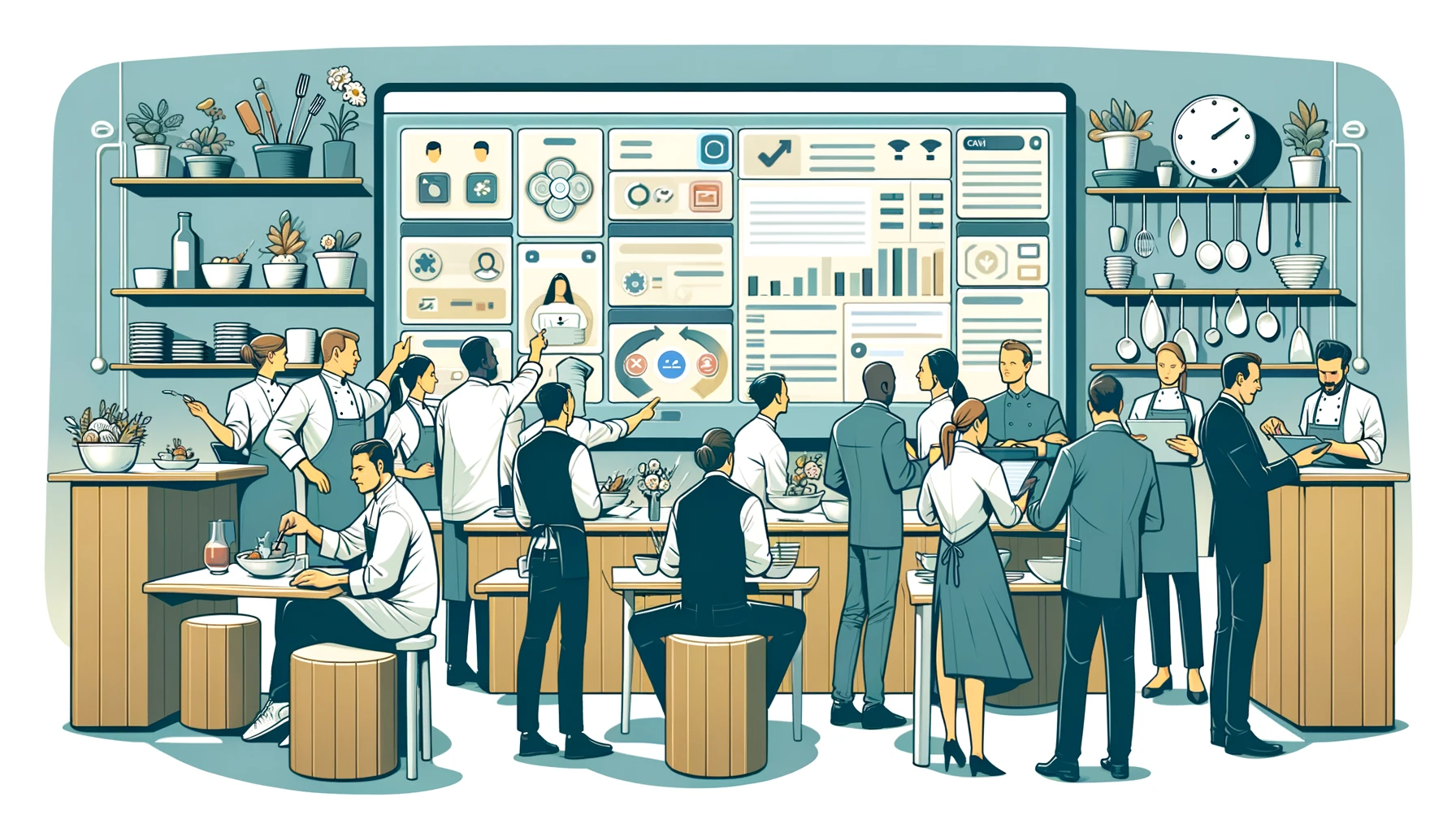
By embracing advanced CRM solutions, you’re not just investing in software; you’re investing in a future where every customer feels valued and every visit counts. Your restaurant can become a place where diners don’t just eat but experience joy, comfort, and a sense of belonging. Now that’s a recipe for success.
Exploring the Features That Set Top-tier Systems Apart
When you’re in the market for a restaurant CRM system, the sheer number of options can be overwhelming. However, understanding the features that distinguish top-tier systems from the rest can guide you to make an informed decision that will benefit your business in the long run.
Key Features of Premier Restaurant CRMs:
-
Comprehensive Customer Profiles: The best CRMs offer detailed customer profiles that go beyond basic contact information. They include dining preferences, allergy information, special dates, and past feedback, enabling truly personalized service.
-
Advanced Analytics: With sophisticated data analysis tools, you can gain insights into customer behavior, peak times, and popular menu items, allowing for data-driven decision-making.
-
Seamless Integration: Top systems seamlessly integrate with point-of-sale (POS) systems, payment processors, and other restaurant management software, creating a unified platform for smoother operations.
-
Multi-channel Communication: Whether it’s through email, SMS, social media, or in-app notifications, a leading CRM will ensure you can reach your customers on their preferred platforms.
Get started with ozma.io software -
Loyalty and Rewards Programs: Encourage repeat business with customizable loyalty programs that are easy to manage and appealing to customers.
-
Automated Marketing Campaigns: Save time and increase effectiveness with automated campaigns that reach the right people at the right time.
-
Mobile Accessibility: In a fast-paced industry, having access to your CRM on the go is crucial. Look for systems with robust mobile apps or mobile-friendly web interfaces.
-
Exceptional Support and Training: A top-tier provider will offer comprehensive training and support to ensure you get the most out of your CRM investment.
To compare the features of some leading CRMs, consider this table:
| Feature | Ozma | Zoho | Odoo |
|---|---|---|---|
| Barcode Generation for Inventory | ✓ | x | x |
| Daily Sales Reports for Management | ✓ | x | x |
| Customizable Menus for Operations | ✓ | x | x |
| Detailed Custom Forms | ✓ | ✓ | x |
| Automated Document Generation | ✓ | ✓ | x |
As you dive into the specifics of each system, remember that your choice should align with your restaurant’s unique needs and goals. The right CRM will not only streamline your operations but will also create a more engaging and satisfying experience for your customers.
And when it comes to visual aids, having a clear graphical representation of these features can greatly enhance your understanding of what each CRM offers.
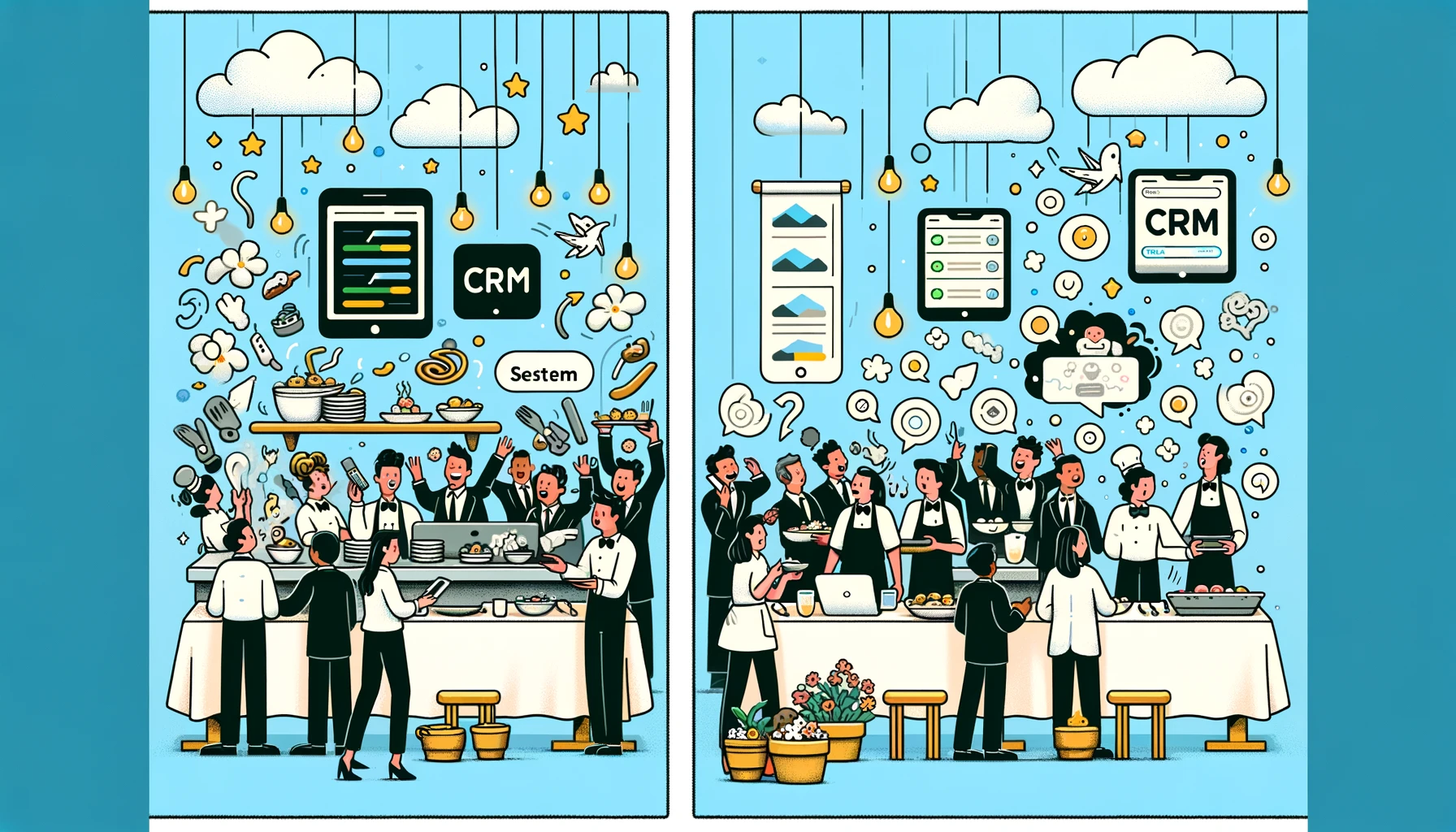
By focusing on these essential features, you can ensure that your restaurant CRM system will help you build stronger relationships with your guests, foster loyalty, and ultimately, drive your business towards greater success.
Streamlining Your Eatery’s Operations with Integrated Management
Efficiency in restaurant operations is like a well-oiled machine—every part needs to work in harmony to deliver the best results. This is where an integrated restaurant CRM system becomes invaluable. By streamlining processes and centralizing data, it supports a smoother operation and provides a comprehensive view of your business.
Key Advantages of Integration:
- Unified Customer Data: All customer interactions and preferences are stored in one place, making it easy to create personalized experiences.
- Consolidated Operations: Integrating with other systems, like POS and inventory, means less manual entry and more accuracy.
- Enhanced Communication: With a centralized system, staff can communicate more effectively, ensuring that everyone is on the same page.
Incorporating a CRM system into your restaurant’s operations can yield significant improvements. Let’s look at some realistic percentages to demonstrate this point:
| Operational Aspect | Performance Before CRM | Performance After CRM | Enhancement |
|---|---|---|---|
| Order Accuracy (%) | 88 |
97 |
+10.2% |
| Inventory Control (%) | 75 |
92 |
+22.7% |
| Employee Productivity (%) | 70 |
85 |
+21.4% |
| Customer Feedback Response Time (hours) | 48 |
24 |
-50% |
An integrated CRM system is a game-changer in managing your eatery’s complex ecosystem. It ensures that customer satisfaction is not left to chance but is a guaranteed outcome of streamlined and efficient operations.
Moreover, the data-driven insights provided by a CRM can help you make informed decisions that can lead to increased profitability and growth. The ability to anticipate customer needs and market trends can set you apart in a competitive industry.
As you consider the ways in which a CRM can enhance your operations, imagine the potential of having all your management tools in one place.
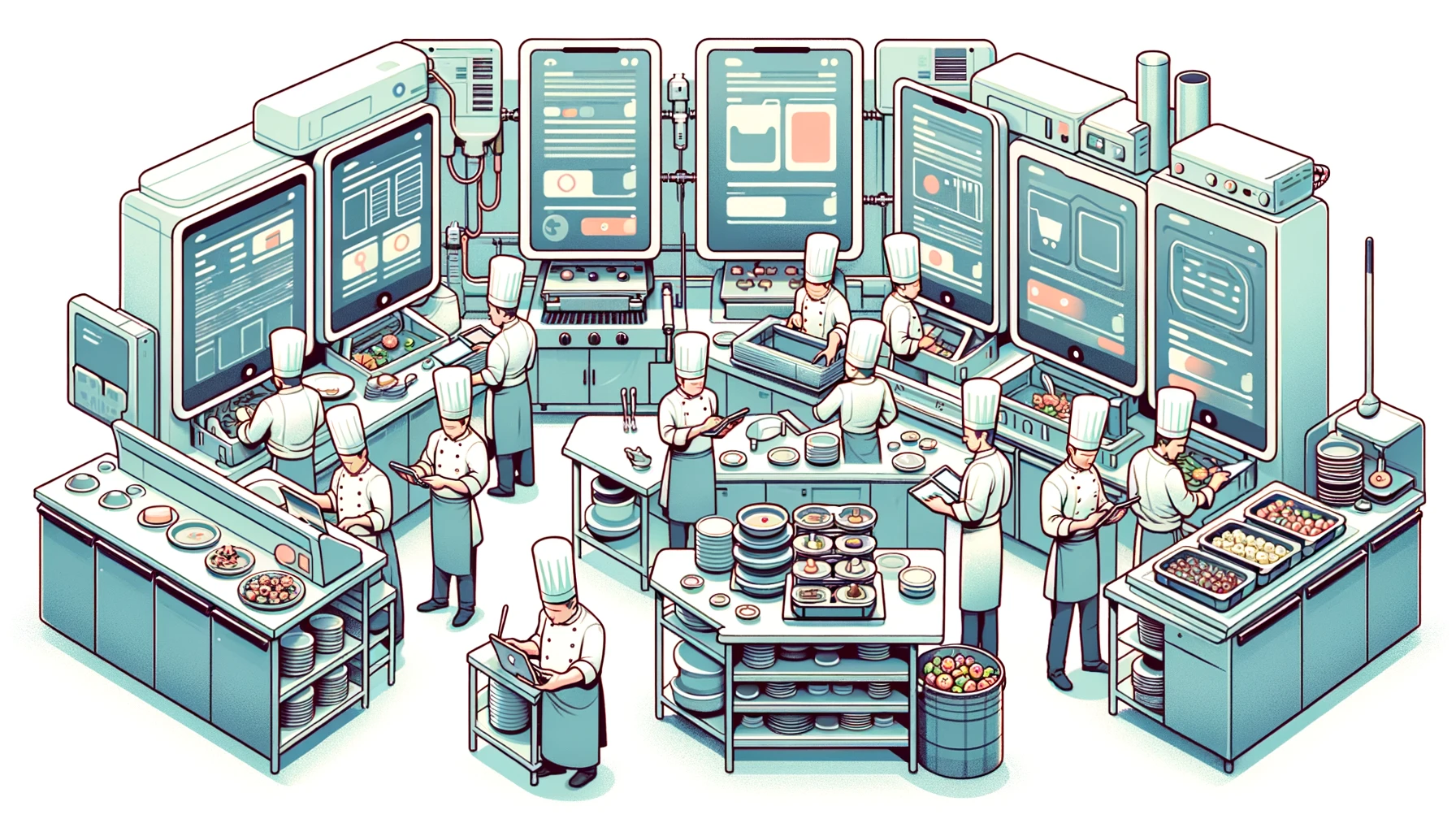
By choosing a restaurant CRM system that offers comprehensive integration capabilities, you’re setting the stage for not just improved management, but for an elevated dining experience that customers will remember and appreciate.
Embrace the future of restaurant management with a CRM that streamlines and simplifies, allowing you and your team to focus on what you do best—creating unforgettable dining experiences.
Personalizing Dining Experiences with Data-Driven Insights
In the competitive landscape of the culinary world, personalization is the secret sauce that sets a restaurant apart. A top-notch restaurant CRM system isn’t just a tool for organizing customer data; it’s a treasure trove of insights that can be used to tailor each guest’s dining experience in a way that feels special and unique.
Harnessing the Power of Customer Data:
By leveraging the rich data collected by your CRM, you can understand and anticipate the needs and preferences of your patrons:
- Menu Customization: Offer recommendations based on previous orders.
- Special Occasions: Remember birthdays and anniversaries to make guests feel celebrated.
- Targeted Promotions: Design offers that resonate with each customer’s dining history.
Engaging with Customers on a New Level:
With the right data, engagement becomes more meaningful:
- Feedback Loop: Use customer reviews to refine your menu and service.
- Responsive Communication: Address customer inquiries with context from their past interactions.
- Reward Loyalty: Create loyalty programs that acknowledge and thank your regulars.
Visualizing the Impact of Personalization:
To truly grasp the effectiveness of personalization, consider this chart that outlines the benefits and their direct impact on customer relations:
| Benefits of Data-Driven Personalization | Impact on Customer Relations |
|---|---|
| Tailored Recommendations | Increased customer satisfaction |
| Recognizing Special Occasions | Enhanced emotional connection |
| Customized Marketing Efforts | Higher engagement and sales |
And to bring these insights to life, here’s a visual representation of how a CRM system can enhance the personalization of dining experiences.
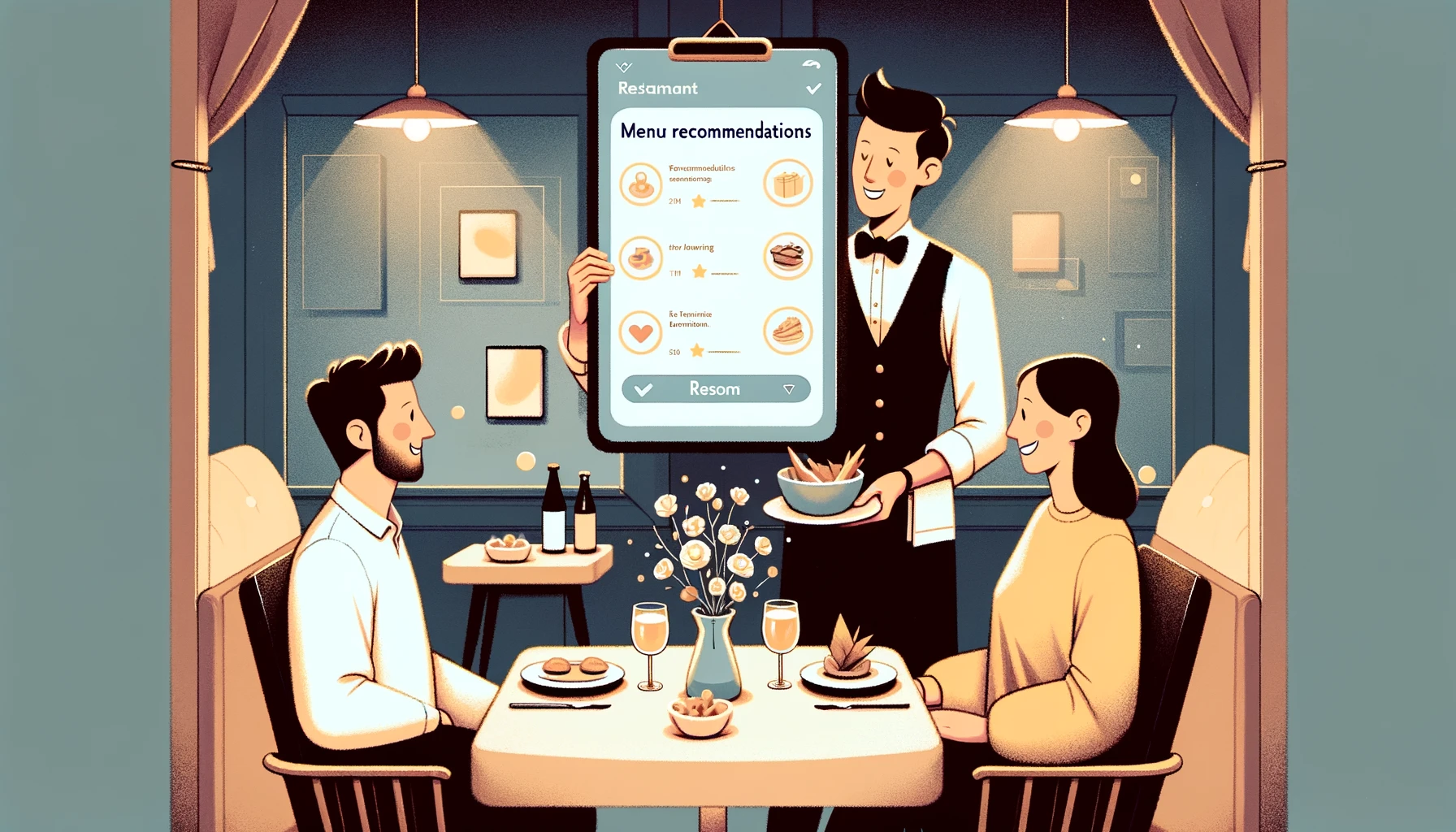
In conclusion, by embracing data-driven personalization through your restaurant CRM system, you’ll not only delight your customers with individual attention but also drive repeat business and foster a loyal customer base. It’s time to transform your data into delectable dining experiences that keep guests coming back for more.
A Step-by-Step Guide to Implementing Your First CRM Tool
Embarking on the journey of implementing your first restaurant CRM system can be both exciting and daunting. But with a clear roadmap, the process can be smooth and transformative for your eatery. Here’s a step-by-step guide to ensure a successful CRM rollout:
Step 1: Assess Your Needs Before diving into the sea of CRM options, take a moment to understand the unique requirements of your restaurant. Do you need to improve customer retention, streamline reservations, or enhance marketing efforts? Identifying these needs will help you choose a system that aligns with your business objectives.
Step 2: Research Potential CRMs With your needs in hand, research CRM tools that offer the features you’re looking for. Compare pricing, scalability, user reviews, and support services to narrow down your choices.
Step 3: Choose the Right Fit Select a CRM that not only meets your current needs but also has the potential to grow with your business. Consider factors like ease of use, integration with existing systems, and the ability to customize.
Step 4: Plan for Implementation Develop a detailed plan for rolling out your new CRM. This should include timelines, staff training, data migration strategies, and contingency plans for any hiccups along the way.
Step 5: Train Your Team A CRM is only as good as the people using it. Invest in comprehensive training for your staff to ensure they’re comfortable with the new system.
Step 6: Go Live and Monitor Launch your CRM and monitor its performance closely. Be prepared to make adjustments as you learn how the system fits into your daily operations.
Step 7: Gather Feedback and Iterate Collect feedback from your team and customers to understand what’s working and what needs improvement. Use this information to refine your CRM usage and continuously enhance your guests’ experiences.
To help visualize the implementation process, refer to the following chart:
| Step | Description |
|---|---|
| Assess Your Needs | Understand the specific challenges and goals of your restaurant. |
| Research Potential CRMs | Compare features, costs, and reviews to identify suitable options. |
| Choose the Right Fit | Pick a CRM that matches your needs and offers scalability. |
| Plan for Implementation | Create a detailed rollout plan with clear milestones. |
| Train Your Team | Ensure staff are well-versed in using the new system. |
| Go Live and Monitor | Start using the CRM and keep an eye on its performance. |
| Gather Feedback and Iterate | Use insights to improve CRM usage and customer satisfaction. |
And for a visual aid, here’s an image depicting the smooth transition from traditional methods to a fully integrated CRM system.
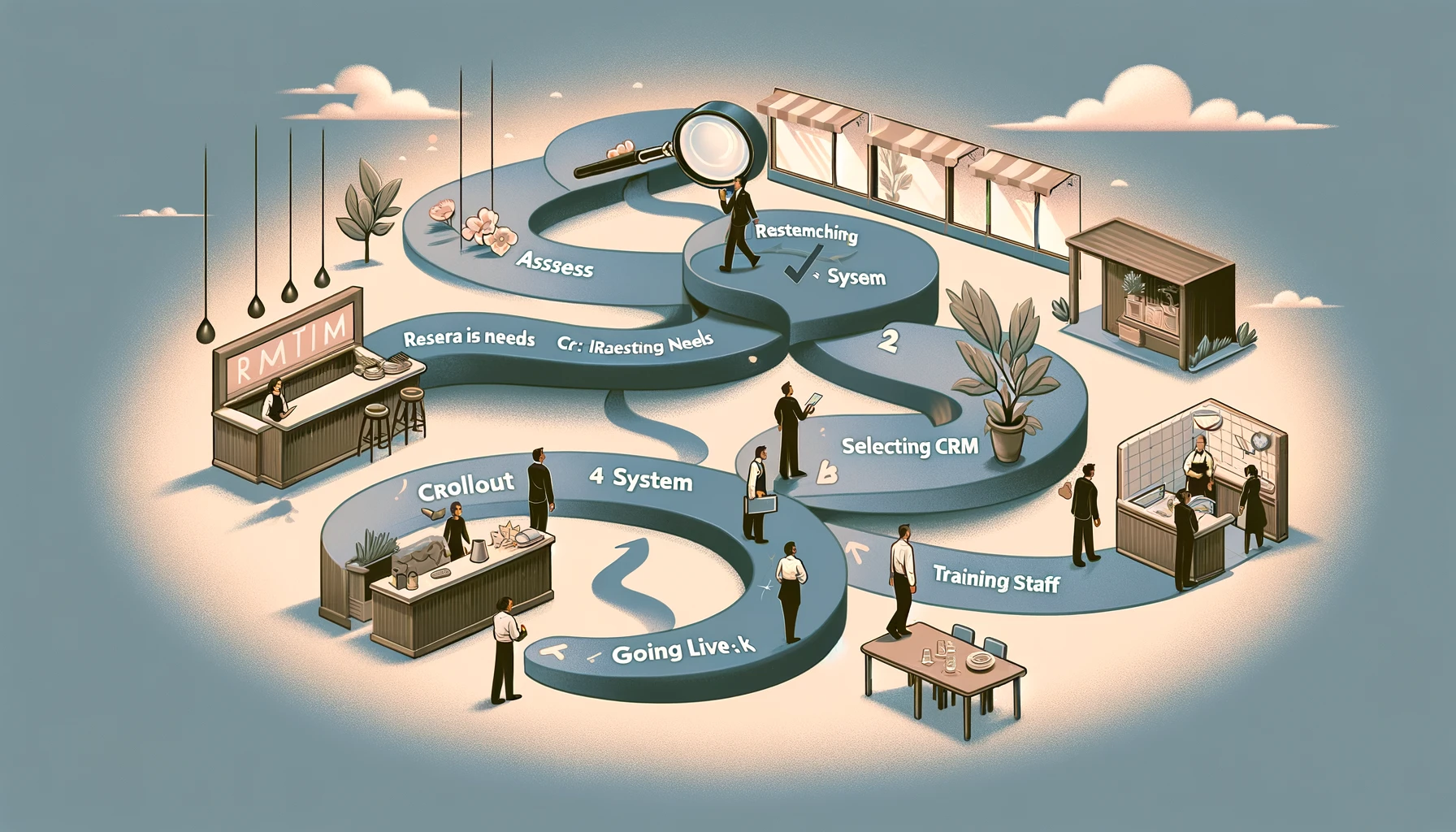
Implementing a restaurant CRM system is a strategic move that can lead to enhanced customer relationships and operational efficiency. With careful planning and execution, your first CRM tool will set the stage for sustained growth and success.
FAQs
What is a restaurant CRM system?
A restaurant CRM system is a software solution designed to manage customer relationships and enhance dining experiences.
How can a restaurant CRM system benefit my business?
It can improve customer service, increase loyalty, streamline operations, and boost repeat business.
What features should I look for in a restaurant CRM system?
Essential features include reservation management, customer data analytics, marketing tools, and feedback collection.
Can a restaurant CRM system help with online ordering?
Yes, many systems integrate with online ordering platforms to track customer preferences and order history.
How does a restaurant CRM system improve customer engagement?
By personalizing the dining experience through tailored marketing, rewards programs, and responsive communication.




